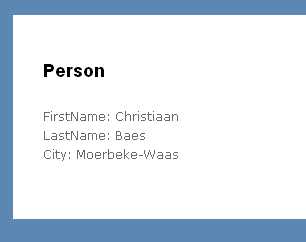I worked a little further on my first ASP.Net spike code. I wanted to have a Person that comes frome a repo to show on the screen with less magic string. First I read a bit in this. But I get bored pretty quickly with reading things so I got back to experimenting. This is the result.
First I create my trusted Person Class.
namespace MvcApplication1.Models
{
public class Person
{
private string lastName;
private string firstName;
public Person(string LastName, string FirstName)
{
lastName = LastName;
firstName = FirstName;
}
public string FirstName { get { return firstName; } set { firstName = value; } }
public string LastName { get { return lastName; } set { lastName = value; } }
}
}```
Then I needed a repository to return somethig. One that has this as an interface.
```csharp
namespace MvcApplication1.Dal.Interfaces
{
public interface IPerson
{
Models.Person FindPerson(int index);
}
}```
And this is one possible implementation.
```csharp
using MvcApplication1.Dal.Interfaces;
namespace MvcApplication1.Dal.Fake
{
public class Person:IPerson
{
public Models.Person FindPerson(int index)
{
return new Models.Person("Baes","Christiaan");
}
}
}```
And then I needed to inject this in my controller. But injecting it via the construcor is a bit more difficult than I thought so I will just create a new one for now in the constructor (next time I will inject).
```csharp
using System;
using System.Collections.Generic;
using System.Linq;
using System.Web;
using System.Web.Mvc;
using MvcContrib;
namespace MvcApplication1.Controllers
{
[HandleError]
public class PersonController : Controller
{
private Dal.Interfaces.IPerson personRepository;
public PersonController()
{
personRepository = new Dal.Fake.Person();
}
public ActionResult Person()
{
var person = personRepository.FindPerson(1);
return View(person);
}
}
}
So I got a fakerepository and I get a person from that. Then I inject that persin into the View. Because I don’t specify a specific View it will just route it to Person, which is fine for now. And no more mahic strings in the controller. Now lets look at the view (.aspx).
<%@ Page Title="" Language="C#" MasterPageFile="~/Views/Shared/Site.Master" Inherits="System.Web.Mvc.ViewPage<MvcApplication1.Models.Person>" %>
<asp:Content ID="Content1" ContentPlaceHolderID="TitleContent" runat="server">
Person
</asp:Content>
<asp:Content ID="Content2" ContentPlaceHolderID="MainContent" runat="server">
<h2>Person</h2>
<p> FirstName: <%= Html.Encode(Model.FirstName)%><br />
LastName: <%= Html.Encode(Model.LastName)%>
</p>
</asp:Content>```
This bit <code class="codespan">Inherits="System.Web.Mvc.ViewPage<MvcApplication1.Models.Person>"</code> makes it so that the Model bit of ViewPage is now strongly typed of type Models.Person. Which means that I can now do Html.Encode(Model.FirstName) so no more ViewData[“FirstName”] this will make refactoring a lot more easy, great.
The result is the same as before. But a little more flexible.
<div class="image_block">
<img src="https://lessthandot.z19.web.core.windows.net/wp-content/uploads/blogs/WebDev/mvcnewproject4.jpg" alt="" title="" width="377" height="278" />
</div>
I can now easily add an attribute to Person.
Lets try that. I will add an attribute City.
```csharp
namespace MvcApplication1.Models
{
public class Person
{
private string lastName;
private string firstName;
private string city;
public Person(string LastName, string FirstName, string City )
{
lastName = LastName;
firstName = FirstName;
city = City;
}
public string FirstName { get { return firstName; } set { firstName = value; } }
public string LastName { get { return lastName; } set { lastName = value; } }
public string City { get { return city; } set { city = value; } }
}
}```
I have to change the fakerepo to add a city, of course. Because I changed the constructor I got a compile error so I know what’s wrong and where (less bugs).
```csharp
using MvcApplication1.Dal.Interfaces;
namespace MvcApplication1.Dal.Fake
{
public class Person:IPerson
{
public Models.Person FindPerson(int index)
{
return new Models.Person("Baes","Christiaan","Moerbeke-Waas");
}
}
}```
No need to change the controller.
Just a little change to the view.
```asp
<%@ Page Title="" Language="C#" MasterPageFile="~/Views/Shared/Site.Master" Inherits="System.Web.Mvc.ViewPage<MvcApplication1.Models.Person>" %>
<asp:Content ID="Content1" ContentPlaceHolderID="TitleContent" runat="server">
Person
</asp:Content>
<asp:Content ID="Content2" ContentPlaceHolderID="MainContent" runat="server">
<h2>Person</h2>
<p> FirstName: <%= Html.Encode(Model.FirstName)%><br />
LastName: <%= Html.Encode(Model.LastName)%><br />
City: <%= Html.Encode(Model.City)%>
</p>
</asp:Content>
With this as the result.

Warning: I’m just learning, I’m not saying what I have here is good practice. Next tie I will start unittesting.




 Chris is awesome.
Chris is awesome.